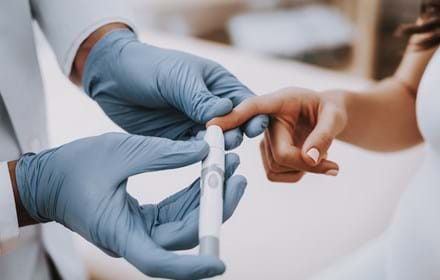
Managing screen-detected type 1 diabetes in young people
Healthcare professionals discuss key areas in screening for new cases of type 1 diabetes.
Looking at what is being done to screen new cases of type 1 diabetes, especially in younger people, and what support is available to families in supporting management of a new diagnosis.
Claire Levy, PR and communications at DRWF, reported from the recent Diabetes UK Professional Conference held recently at the SEC in Glasgow.
This session was chaired by previously funded DRWF researchers Professor Kathleen Gillespie, Professor of Molecular Medicine, University of Bristol and Professor Susan Wong CBE, Professor of Diabetes and Metabolism and Honorary Consultant Physician in Diabetes, Cardiff University.
Professor Wong was recently awarded a Commander of the British Empire (CBE) for her outstanding services to diabetes and metabolism.
A session on preparing for early detection and treatment of type 1 diabetes featured presentations from leading healthcare professionals in this field. Here we report on an update on managing screen-detected type 1 diabetes in young people.
DRWF-funded researchers Professor Kathleen Gillespie and Professor Susan Wong CBE, who chaired the session, with Claire Levy of DRWF
Dr Rachel Besser, Consultant paediatric endocrinologist, T1D researcher at Oxford Children's Hospital and University of Oxford, discussed the importance of monitoring young people newly diagnosed with type 1 diabetes following screening.
Dr Besser introduced her session with the presentation of a case study:
“This is a three-year-old who pitched up in my pre-type 1 diabetes clinic in Oxford. Her sister has type 1 diabetes, and she had then proceeded to a research study and was positive for three islet autoantibodies. These were confirmed, and then she underwent metabolic staging with an oral glucose tolerance test. The mother told me she didn't want her to be part of a research trial, and these are the questions I ask.
“What is her stage? What is her risk? And how should I follow her up?
“To remind you she has two or more islet antibodies, so she has early-stage type 1 diabetes. The question is not will she need insulin? The question is when will she need insulin? And that is in contrast to individuals who have a single islet, autoantibody, who have a much lower risk of ever progressing to insulin therapy. She is in stage two. She has dysglycaemia on the two hour an oral glucose tolerance test (OGTT) value. She has a much higher risk of progression, 75% over five years. But what makes me worried is she is very young.
“These children have a much higher risk of progressing rapidly. I am going to discuss why we need to monitor these screen positive individuals.
“There are good reasons that we should monitor individuals. We can prevent diabetes for no good apparent reasons. These are preceding the pandemic. We can plan and prepare children for a life with type 1 diabetes.
“Ideally, we want to delay the need for insulin. Some of the benefits and the evidence we see from screening programmes. We can reduce diabetic ketoacidosis (DKA) regardless of how we screen, whether it is antibodies alone or combined with genetics. If you do not have DKA, you do not need to be hospitalised, and you can start insulin therapy as an outpatient. These children, when they are diagnosed with stage three, their HbA1c is much lower.
“The benefits of screening are only seen with active monitoring. There have been a number of studies that have shown this.
“You can see the DKA rates are the same regardless of whether you are screened compared to if you are screened and have no follow-up. The only time you see a reduction in DKA is in families who engage in that follow-up, and that also translates into the HbA1c at diagnosis of clinical type 1 diabetes.
“Engaging individuals in follow-up is really challenging.
“Data taken from TrialNet, more than 5,000 children and adults who had a confirmed test to be antibody positive, and of those who had multiple islet autoantibodies, they were invited for a staging OGTT and monitoring and only two thirds turned up.
“This is supported by data from the TEDDY study, another birth cohort study where on average there was only 62 adherence to the monitoring protocol, and that varied in different countries.
“It was as low as 48% in Germany and America, and it only reached adherence to 78% in Finland. And monitoring is important not just for research, but also for clinical care.
“We need to figure out what we are going to do in clinical care. What are the options for monitoring? Well, we have heard from the OGTT is the gold standard for staging. And it's the gold standard for monitoring. We know it involves an invasive test – 2 to 5 blood draws over two hours – but it is useful not just for the stage, but we can combine metrics associated with the risk of progression, to give a combined risk progression score. The trouble is, look at that five-year risk. These children and adults may be having OGTT for many, many years, so it is no surprise that they may drop out. What about HbA1c, something we all know and love?
“We can teach them about carbohydrate counting, start doing the plan and prepare for insulin therapy. HbA1c is not perfect. It is highly specific, but it is insensitive. Therefore, we need to provide glucose monitors because you can have a high glucose and a normal HbA1c level.
“We are going to need to figure out how to do education, how individuals will use this at home and it is going to be costly.
“If someone has an initial positive islet autoantibody screen, it is really important that this is confirmed with a second sample. That is to reduce false positivity, to ensure autoantibody persistence and the validity of the target antigen. A second sample should happen within three months. It should happen in a lab that has appropriate standardised thresholds for population screening. I'm not sure our NHS labs have that.
“At a young age it is very important because these are higher risk children. This is why we have come up with this recommendation that is based on the age and the duration. If you're very young, we do the monitoring a bit more frequently.
“We have to monitor, give education and decide when to start them on insulin. Education and support is absolutely crucial. We know that accurate risk perception is absolutely integral with keeping individuals involved in the follow-up programme. We should assess anxiety, depression, behaviour change, and it should be appropriate to the developmental stage and age of that child and account for the fact that if there is a family history of type 1 diabetes the parents are going to have other views.
“We are looking for this “sweet spot” of healthy concern. We do not want to give so much stress that there is a lot of anxiety. But we do not want to give too little that it is completely ignored. The most important thing I would say is that we should pair information with actionable steps.
“This is an example of some of the materials I use in my pre-type 1 clinic – I provide who to contact. We have safety net advice, and they know what is going to happen.
“Back to our case study. What happened to her? We provided her with a home glucose meter. And then we repeated the HbA1c and then introduced CGM at three-month intervals. And this is what happened.
“A classic CGM trace of a child with pre-type 1 diabetes who was transitioning to stage three. We see a rise in glucose values, typically towards the end of the day.
“This does not mean you start on insulin. We started this child on intermittent prandial insulin above a carbohydrate threshold, so we had time to educate the family about carbohydrate counting. We knew when the glucose excursion was happening. This was all done as an outpatient.
“Adults are less studied, even though there are more adults diagnosed with type 1 diabetes than children. There are high rates of misdiagnosis with type 2 diagnosis, and that really puts adults at risk of DKA. Adults have a lower risk of progression. Data from children and adults who have dysglycaemia have a much slower rate of progression. Sometimes they do not even ever reach the point where they need insulin.
“To summarise and conclude, the benefits of screening are only seen with an active monitoring programme.
“OGTT is needed for staging. But for very young children we can use other less invasive options. We want to prevent DKA, and we want to be able to offer licensed therapies and trials.”
Read our other reports:
Delaying the need for insulin in people with pre-type 1 diabetes
Preparing for early detection and treatment of type 1 diabetes
A later diagnosis and a day less with type 1 diabetes
I would like to make a regular donation of
I would like to make a single donation of
There are lots of ways to raise money to support
people living with all forms of diabetes.
Bake, Swim, Cycle, Fly ... Do It For DRWF!
Fundraise with us
Recent News


